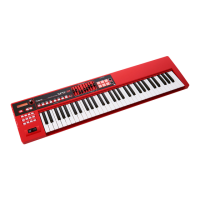Playing the XPS-10
16
Adjusting the Volume of the Parts in Split/Dual
Mode
If Split or Dual (p. 14) are on, you can use the sliders to adjust the upper
(part 1) and lower (part 2) volume.
Adjusting the upper (part 1) volume
Here’s how to adjust the volume of the upper part in Split mode or of part 1
in Dual mode.
1. Move the SPLIT/DUAL [UPPER/1] slider.
Moving the slider up increases the volume; moving it down decreases the
volume.
MEMO
This also adjusts the volume of part 1 when you’re in 16-part mode.
NOTE
Changes you make are temporary, and are discarded if you turn o the
power or select another sound. If you want to keep the changes that
you made, save the performance (p. 27).
Adjusting the lower (part 2) volume
Here’s how to adjust the volume of the lower part in Split mode or of part 2
in Dual mode.
1. Move the SPLIT/DUAL [LOWER/2] slider.
Moving the slider up increases the volume; moving it down decreases the
volume.
MEMO
This also adjusts the volume of part 2 when you’re in 16-part mode.
NOTE
Changes you make are temporary, and are discarded if you turn o the
power or select another sound. If you want to keep the changes that
you made, save the performance (p. 27).
Changing the Keyboard’s Pitch in One-
Octave Steps (OCTAVE SHIFT)
“Octave Shift” is a setting that lets you change the pitch of the keyboard in
steps of an octave.
1. Press the OCTAVE [DOWN] or [UP] button.
Pressing the [DOWN] button will lower the pitch of the currently selected
tone by one octave; pressing the [UP] button will raise it by one octave.
< OCTAVE +1>
When you press this button, the value of the setting is displayed at the top
of the screen. The screen is restored a short time after you release the
button.
You can change the pitch in a range of 3 octaves down (-3) to 3 octaves up
(+3).
If this setting is other than “0,” OCTAVE [DOWN] or [UP] button will light.
You can reset this setting to “0” by pressing OCTAVE [DOWN] and
[UP] buttons simultaneously.
What’s aected by the Octave Shift setting will depend on the current
settings.
When playing a single Tone
The octave of the selected tone will change. The setting cannot be saved.
When playing multiple Tones
The current settings will determine what is aected by Octave Shift.
For Dual
The octave of all parts will change.
You can save the Octave setting of each part by saving the performance
settings (Performance).
For Split or 16-part mode
The octave of the currently selected patch (part) will change.
You can set this independently for each part.
You can save the Octave setting of each part by saving the performance
settings (Performance).
Shifting the Key Range in Semitone Steps
(TRANSPOSE)
The Transpose function allows you to shift the key range in semitone steps.
This is also convenient when you’re playing musical notation that’s written
for a transposing instrument such as a trumpet or clarinet, and want to play
the notes as printed.
1. Hold down the [TRANSPOSE] button, and press the
OCTAVE [DOWN] or [UP] buttons.
Set how far you want to transpose in semitone steps from G (-5 semitones)
to F# (+6 semitones).
<TRANSPOSE B>
When you press this button, the value of the setting is displayed at the top
of the screen. The screen is restored a short time after you release the
button.
If a value other than “C” is set, the [TRANSPOSE] button is lit.
To reset the value to “C,” hold down the [TRANSPOSE] button and press the
OCTAVE [DOWN] and [UP] buttons simultaneously.
Playing Arpeggios (ARPEGGIO)
When you press the [ARPEGGIO] button once, it is lit to show that Arpeggio
is turned on.
“Arpeggio” is a playing style where you play the individual notes of a chord
separately. If you use XPS-10’s Arpeggio function, you just have to play the
chords to play arpeggios according to their component notes.
NOTE
The arpeggio settings cannot be saved.
1. Press the [ARPEGGIO] button so it’s lit.
<ARPEGGIO> 001
Basic 1 (a)
TIP
If you hold down the [SHIFT] button and press the [ARPEGGIO] button,
the ARPEGGIO screen appears with Arpeggiator Hold turned on.
2. Use the CURSOR [
K
] [
J
] buttons to move the cursor to the
item that you want to edit.
3. Use the VALUE [-] [+] buttons to set the desired value.

